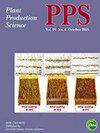Carbohydrates accumulation, oil quality and yield of rapeseed genotypes at different nitrogen rates
IF 1.3
3区 农林科学
Q2 AGRONOMY
引用次数: 3
Abstract
ABSTRACT A field experiment was conducted in 2018–2020 to investigate the effect of two nitrogen application rates (N0 = 0 kg ha−1(control), N90 = 90 kg ha−1, and N180 = 180 kg ha−1) on morphological and physiological behaviours of two new rapeseed varieties; V1 = JYJS01 (semi-dwarf variety) and V2 = CY36 (tall variety). Our results indicated that N application enhanced the plant growth and seed protein content in comparison to control. Contrastingly, compared with control, sugar contents, i.e. sucrose and reducing sugars, decreased significantly in response to an increase in N. Seed oil content also decreased by 8.5% and 5.5%, 6.7% and 3.9% against N180 in V1 and V2 during 2019 and 2020, respectively. Furthermore, higher nitrogen application rates decreased seed fatty acid proportions by decreasing the sugar availability for fatty acid biosynthesis. Our results demonstrated the highest seed yield (9.4 g plant−1 in 2018/19 and 9.5 g plant−1 in 2019/20) in V2 against N180, and the lowest seed yield (3.2 g plant−1 in 2018/19 and 3.4 g plant−1 in 2019/20) in V1 at control. These findings imply that a high nitrogen application rate had increased the yield. At the same time, the carbohydrates translocation from stems to seed for fatty acid biosynthesis decreased, which played their significant role in seed physiology for fatty acid metabolisms, ultimately affected the seed quality. However, there is still a dire need to evaluate how nitrogen application affect the carbohydrate availability for fatty acid metabolism in the seed of new winter rapeseed varieties. Graphical abstract不同施氮量下油菜籽基因型碳水化合物积累、油质及产量的变化
摘要在2018-2020年进行了一项田间试验,研究了两种施氮量(N0=0 kg ha−1(对照)、N90=90 kg ha−2和N180=180 kg ha−3)对两个油菜新品种形态和生理行为的影响;V1=JYJS01(半矮秆品种)和V2=CY36(高大品种)。我们的结果表明,与对照相比,施氮提高了植物生长和种子蛋白质含量。相比之下,与对照相比,糖含量,即蔗糖和还原糖,随着N含量的增加而显著下降。2019年和2020年,V1和V2的籽油含量也分别比N180下降8.5%和5.5%、6.7%和3.9%。此外,较高的氮施用率通过降低脂肪酸生物合成的糖可利用性来降低种子脂肪酸比例。我们的研究结果表明,在对照组中,V2的种子产量最高(2018/19年为9.4 g植物−1,2019/20年为9.5 g植物−2),V1的种子产量最低(2018-19年为3.2 g植物−3,2019/2年为3.4 g植物−4)。这些发现表明,高氮施用率提高了产量。同时,碳水化合物从茎向种子进行脂肪酸生物合成的转运减少,这在种子的脂肪酸代谢生理中发挥了重要作用,最终影响了种子的品质。然而,仍然迫切需要评估施氮如何影响冬油菜新品种种子中脂肪酸代谢的碳水化合物有效性。图形摘要
本文章由计算机程序翻译,如有差异,请以英文原文为准。
求助全文
约1分钟内获得全文
求助全文
来源期刊

Plant Production Science
农林科学-农艺学
CiteScore
5.10
自引率
4.00%
发文量
27
审稿时长
>36 weeks
期刊介绍:
Plant Production Science publishes original research reports on field crops and resource plants, their production and related subjects, covering a wide range of sciences; physiology, biotechnology, morphology, ecology, cropping system, production technology and post harvest management. Studies on plant production with special attention to resource management and the environment are also welcome. Field surveys on cropping or farming system are also accepted. Articles with a background in other research areas such as soil science, meteorology, biometry, product process and plant protection will be accepted as long as they are significantly related to plant production.
 求助内容:
求助内容: 应助结果提醒方式:
应助结果提醒方式:


